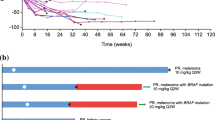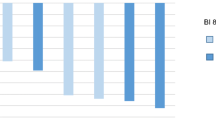Abstract
Purpose
The aim of the study was to evaluate the safety and determine the maximum tolerated dose (MTD) of intravenous catumaxomab, a trifunctional bispecific antibody that binds to EpCAM on epithelial cancer cells and CD3 on T cells.
Methods
The trial was a dose-escalation study with a 3 + 3 design in epithelial cancers with known EpCAM expression. The dose-limiting toxicity (DLT) period consisted of 4 weeks, with weekly intravenous administration of catumaxomab. Key DLTs were ≥grade 3 optimally treated non-hematological toxicity; ≥grade 3 infusion-related reactions refractory to supportive care; ≥grade 3 increase in liver enzymes and/or bilirubin not resolving to grade 2.
Results
Sixteen patients were enrolled receiving doses of 2 (n = 5), 4 (n = 3), 7 (n = 7) and 10 µg catumaxomab (n = 1). The most common treatment-emergent adverse events (TEAEs) were chills (93.8 %) and pyrexia (87.5 %). The most common TEAE of grade ≥3 was transient dose-dependent increases in aspartate aminotransferase (56.3 %). The intensity of toxicities decreased with the number of infusions. Also, serum IL-6 increased in a dose-dependent manner and reverted to low or undetectable levels after four infusions. A reversible decrease in liver function test (prothrombin time) at the 7-µg dose level was considered a DLT. The first patient at 10 µg experienced a fatal hepatic failure related to catumaxomab that led to the termination of the study.
Conclusions
The MTD of weekly intravenous catumaxomab was 7 µg. Major toxicities were cytokine release-related symptoms and hepatotoxicity.


Similar content being viewed by others
References
Went P, Lugli A, Meier S et al (2004) Frequent EpCAM protein expression in human carcinomas. Hum Pathol 35:122–128
Went P, Vasei M, Bubendorf L et al (2006) Frequent high-level expression of the immunotherapeutic target EpCAM in colon, stomach, prostate and lung cancers. Br J Cancer 94:128–135
Spizzo G, Went P, Dirnhofer S et al (2004) High EpCAM expression is associated with poor prognosis in node-positive breast cancer. Breast Cancer Res Treat 86:207–213
Spizzo G, Went P, Dirnhofer S et al (2006) Overexpression of epithelial cell adhesion molecule (EpCAM) is an independent prognostic marker for reduced survival of patients with epithelial ovarian cancer. Gynecol Oncol 103:483–488
Balzar M, Winter MJ, de Boer CJ et al (1999) The biology of the 17-1A antigen (EpCAM). J Mol Mod 77:699–712
Pauli C, Muenz M, Kieu C et al (2003) Tumor-specific glycosylation of the carcinoma-associated epithelial cell adhesion molecule EpCAM in head and neck carcinomas. Cancer Lett 193:25–32
Lindhofer H, Mocikat R, Steipe B et al (1995) Preferential species-restricted heavy/light chain pairing in rat/mouse quadromas. Implications for a single-step purification of bispecific antibodies. J Immunol 155:219–225
Zeidler R, Reisbach G, Wollenberg B et al (1999) Simultaneous activation of T cells and accessory cells by a new class of intact bispecific antibody results in efficient tumor cell killing. J Immunol 163:1246–1252
Zhang S, Zhang HS, Cordon-Cardo C et al (1998) Selection of tumor antigens as targets for immune attack using immunohistochemistry: protein antigens. Clin Cancer Res 4:2669–2676
Riesenberg R, Buchner A, Pohla H et al (2001) Lysis of prostate carcinoma cells by trifunctional bispecific antibodies (alpha EpCAM x alpha CD3). J Histochem Cytochem 49:911–917
Zeidler R, Mysliwietz J, Csanady M et al (2000) The Fc-region of a new class of intact bispecific antibody mediates activation of accessory cells and NK cells and induces direct phagocytosis of tumour cells. Br J Cancer 83:261–266
Schmitt M, Schmitt A, Reinhardt P et al (2004) Opsonization with a trifunctional bispecific (alphaCD3 x alphaEpCAM) antibody results in efficient lysis in vitro and in vivo of EpCAM positive tumor cells by cytotoxic T lymphocytes. Int J Oncol 25:841–848
Seimetz D, Lindhofer H, Bokemeyer C (2010) Development and approval of the trifunctional antibody catumaxomab (anti-EpCAM x anti-CD3) as a targeted cancer immunotherapy. Cancer Treat Rev 36:458–467
Heiss MM, Murawa P, Koralewski P et al (2010) The trifunctional antibody catumaxomab for the treatment of malignant ascites due to epithelial cancer: results of a prospective randomized phase II/III trial. Int J Cancer 127:2209–2221
Petrelli F, Borgonovo K, Lonati V et al (2013) Regression of liver metastases after treatment with intraperitoneal catumaxomab for malignant ascites due to breast cancer. Target Oncol 8:291–294
Bezan A, Hohla F, Meissnitzer T et al (2013) Systemic effect of catumaxomab in a patient with metastasized colorectal cancer: a case report. BMC Cancer 13:618
Sebastian M, Passlick B, Friccius-Quecke H et al (2007) Treatment of non-small cell lung cancer patients with the trifunctional monoclonal antibody catumaxomab (anti-EpCAM x anti-CD3): a phase I study. Cancer Immunol Immunother 56:1637–1644
Le Tourneau C, Lee JJ, Siu LL (2009) Dose escalation methods in phase I cancer clinical trials. J Natl Cancer Inst 101:708–720
Ruf P, Kluge M, Jäger M et al (2010) Pharmacokinetics, immunogenicity and bioactivity of the therapeutic antibody catumaxomab intraperitoneally administered to cancer patients. Br J Clin Pharmacol 69:617–625
Amacher DE (1998) Serum transaminase elevations as indicators of hepatic injury following the administration of drugs. Regul Toxicol Pharmacol 27:119–130
Suntharalingam G, Perry MR, Ward S et al (2006) Cytokine storm in a phase 1 trial of the anti-CD28 monoclonal antibody TGN1412. N Engl J Med 355:1018–1028
Riechelmann H, Wiesneth M, Schauwecker P et al (2007) Adoptive therapy of head and neck squamous cell carcinoma with antibody coated immune cells: a pilot clinical trial. Cancer Immunol Immunother 56:1397–1406
Bugelski PJ, Achuthanandam R, Capocasale RJ et al (2009) Monoclonal antibody-induced cytokine-release syndrome. Expert Rev Clin Immunol 5:499–521
Burges A, Wimberger P, Kümper C et al (2007) Effective relief of malignant ascites in patients with advanced ovarian cancer by a trifunctional anti-EpCAM x anti-CD3 antibody: a phase I/II study. Clin Cancer Res 13:3899–3905
Pietzner K, Vergote I, Santoro A et al (2014) Re-challenge with catumaxomab in patients with malignant ascites: results from the SECIMAS study. Med Oncol 31:308
Thomaidis T, Wörns MA, Galle PR et al (2014) Treatment of malignant ascites with a second cycle of catumaxomab in gastric signet cell carcinoma—a report of 2 cases. Oncol Res Treat 37:674–677
Acknowledgments
We are grateful to the participating patients and their families. Professor Meinolf Karthaus (Chair) and Professor Lena Specht served as voting members of the Dose Steering Board. Statistician Ib Jarle Christensen is acknowledged for excellent statistical advice. The trial was sponsored by Neovii Biotech GmbH, formerly Fresenius Biotech GmbH. Medical writing assistance was provided by Neovii Biotech GmbH.
Conflict of interest
M.M.S served on an advisory board for Fresenius Biotech GmbH. C.D declares no potential conflict of interest concerning catumaxomab and its development. R.D declares no potential conflicts of interest. U.L declares no potential conflict of interest W.B declares no potential conflict of interest concerning catumaxomab and its development. H.M is an employee of Neovii Biotech GmbH. J.T declares no potential conflicts of interest.
Author information
Authors and Affiliations
Corresponding author
Rights and permissions
About this article
Cite this article
Mau-Sørensen, M., Dittrich, C., Dienstmann, R. et al. A phase I trial of intravenous catumaxomab: a bispecific monoclonal antibody targeting EpCAM and the T cell coreceptor CD3. Cancer Chemother Pharmacol 75, 1065–1073 (2015). https://doi.org/10.1007/s00280-015-2728-5
Received:
Accepted:
Published:
Issue Date:
DOI: https://doi.org/10.1007/s00280-015-2728-5




